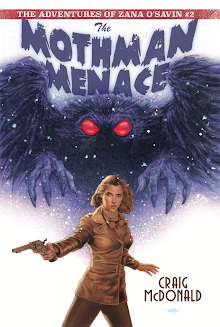 |
| A first pass at the ROLL THE CREDITS cover for Betimes Books by designer J.T. Lindroos |
The novel also focuses on a storied period of Hector's life hinted at from the series' beginning—namely, the author/screenwriter's controversial activities during the Second World War.
Like Hemingway, Hector went to Europe as a middle-aged war correspondent. Once there, he morphed into a kind of guerilla resistance chief, actively scouting enemy positions, carrying weapons, and as Hemingway is believed to have done, actually engaging in some level of armed combat.
But ROLL THE CREDITS is also a much bigger tale, focusing on a Nazi filmmaker and the German Expressionist film movement's influence on American film noir.
 |
| Another early version of ROLL THE CREDITS cover |
World War II and cinema history: The challenge was to find a way to encapsulate these big themes in a cover image that would telegraph the novel awaiting readers.
Arguably, the novel was the most challenging to realize in terms of cover design.
I eventually hit on some vague notions of disparate images/character portraits that could be dropped into a sequence of film cells, maybe imposed over a bigger backdrop.
Having used the Eiffel Tower on the cover of the first Lassiter novel, the Paris-set ONE TRUE SENTENCE, it seemed right at the series' midpoint and return to Paris to once again put the tower on the cover but in a sinister new context.
We looked at several different image options, fairly quickly coming to an overall design concept.
Once we locked in the larger concept, designer J.T. Lindroos then focused on finding the right color scheme.
Befitting a novel written around the shadowy, high-contrast world of film noir, a predominantly black-and-white cover seemed a natural choice...
At last we settled on:
———————









































No comments:
Post a Comment